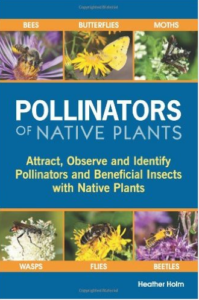Milkweed is always a sellout item at our plant sales. The plight of the monarch has caught the public’s attention as few conservation efforts ever have. It is encouraging to see citizens so galvanized behind an environmental cause!
But I wonder if by focusing on one favored butterfly we aren’t seeing the bigger picture – many pollinators are in trouble, not just the cute ones. Bees, beetles, flies, moths … numerous species are in frightening decline. Even the beloved firefly is struggling. These important critters contribute to our way of life through agriculture, science, and stabilization of food webs. It is going to take more than milkweeds to help bring back our pollinator populations. Following are links to organizations and reference information that can help you be effective in the fight against pollinator loss.
Pollinators Come in All Shapes and Sizes
Ants are pollinators, wasps are pollinators …beetles and midges and even bats! Butterflies may be the most flashy and charismatic pollinator, but let’s not make it a popularity contest. If you are interested in being part of the pollinator conservation movement, be sure your efforts include multiple pollinator species. Click here for a slideshow of pollinator facts, or here to learn about the many different species of pollinators in Kansas.

Find this book by Heather Holm in our gift shop – plant and insect profiles to help you host a pollinator palloza!
Season Long Nectar is Critical
Variety is the spice of life! Try to plant several species of wildflowers with varying bloom times, providing nectar sources that stretch through the season. Different pollinator populations peak at various times through the warm months, so provide for them by having a long blooming garden. Early spring and late fall flowers can help sustain migrating species in the difficult stages of their journey. Research from Cornell concerning east coast monarch migration suggests lack of late season nectar is more crucial to their success than milkweed. Help these insects get the energy they need all through year!
Host Plants that Work in Your Area
Want to nurse some larvae in your backyard? Find the host plants that cater to pollinators in your area. Milkweeds (Asclepias sp.) host monarch caterpillars, yes, but another plant to try is spicebush (Lindera benzoin) for the tiger swallowtail. Rattlesnake master (Eryngium yuccafolium) hosts the borer moth (Papaipema eryngii), also a favorite of wasps. Do your research before you plant to ensure that your garden will be appealing to pollinators native to your region. This link has great information on how to create pollinator habitat in the Great Plains region. This one has planting guides for US ecoregions.
![Tiger Swallotail By BLM Nevada (Tiger Swallowtail Butterfly) [CC BY 2.0 (http://creativecommons.org/licenses/by/2.0)], via Wikimedia Commons Tiger Swallotail By BLM Nevada (Tiger Swallowtail Butterfly) [CC BY 2.0 (http://creativecommons.org/licenses/by/2.0)], via Wikimedia Commons](https://dyckarboretum.org/wp-content/uploads/2016/09/Tiger_Swallowtail_Butterfly_19984085821-300x225.jpg)
Tiger Swallowtail, By BLM Nevada (Tiger Swallowtail Butterfly) [CC BY 2.0 (http://creativecommons.org/licenses/by/2.0)], via Wikimedia Commons

“Great golden digger wasp with sand wasp in background” on a rattlesnake master flower. Image from North Carolina Museum of Natural Sciences
Team Up With The Little Guys
We have all heard of organizations that rescue cats and dogs or save pandas from poaching. But who is looking out for the little guys? There are some wonderful organizations fighting to protect threatened species of insects and other invertebrates. Consider giving your time, talents or money to these organizations to help them carry out conservation projects. Check out their websites for helpful resources.
The Xerces Society “is a nonprofit organization that protects wildlife through the conservation of invertebrates and their habitat.” They have ongoing programs for butterfly and pollinator conservation. Monarch Watch is a nonprofit that focuses on education and conservation efforts for the monarch butterfly, based at the University of Kansas.
Pollinator Partnership is “dedicated exclusively to the protection and promotion of pollinators and their ecosystems.”
As you continue to create monarch weigh stations with proud stands of milkweed, remember that there are lots of other less popular pollinators that need our care and concern. Wasps, bees, ants and beetles may not be as beautiful as butterflies, but they too contribute to the balance of our ecosystem.
